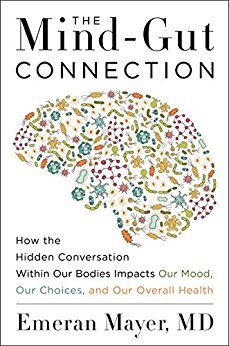More on this book
Community
Kindle Notes & Highlights
by
Emeran Mayer
Read between
March 13 - April 16, 2017
gastrin,
secretin—turned
somatostatin
These gut peptides have also ...
This highlight has been truncated due to consecutive passage length restrictions.
gut hor...
This highlight has been truncated due to consecutive passage length restrictions.
gut peptides were present not only in the intestine’s hormone-containing cells, but also in the nerve cells of the enteric nervous system, which used them to fine-tune
peristalsis, fluid absorption, and secretion.
They grew different microorganisms in a nutrient-containing broth, separated the microorganisms from the broth, and tested them for the presence of
insulin,
In both the cells and the broth, they found molecules similar to human insulin—similar
in addition to insulin, my colleagues found molecules similar to other mammalian gut peptides.
noradrenaline, endorphins, and serotonin
and their rec...
This highlight has been truncated due to consecutive passage length restrictions.
have since been id...
This highlight has been truncated due to consecutive passage length restrictions.
we proposed that these signaling molecules represent the words of a universal biological language used not only by the gut, but also by the nervous system, including the little brain and the big brain, and by the immune system.
frogs, plants, and even microbes living inside our intestines used it as well.
Dahlia’s,
story strongly suggests that changes in the normal development of a healthy gut microbiome can put patients at risk of developing psychiatric symptoms as well as a lifelong miscommunication between the gut and the brain.
we now know from scientific studies that there is some validity to the fear of microbes in our gut and of the many substances they can produce.
Some of these transient microorganisms,
in particular parasites and viruses,
have their ow...
This highlight has been truncated due to consecutive passage length restrictions.
Toxoplasma gondii.
can actually infiltrate the brain of any mammal (including humans), by outsmarting the blood-brain barrier, which functions as a firewall to isolate and protect the brain from any unwanted influences.
cats excrete the parasite, and rodents subsequently ingest it.
The ingested cysts reproduce in the cat’s gastrointestinal tract, the cat sheds newly hatched parasites in its feces, and the cycle of life continues.
toxoplasma-infected rodents not only lose their instinctive fear of cats—they also begin to prefer areas that smell like cat urine.
This clever hijacking of the rat brain’s operating systems overwhelms the innate fear response by causing a sexual attraction to cat odor. In other words, the infected rats develop a fatal attraction to cats.
our bodies actually organize gut reactions and gut feelings in the form of an elaborate brain-gut circuitry that includes the gut microbiota as an essential component.
we have realized only in the last few years—to
that our gut microbes play an integral role in this interaction between gut reactions and sensations.
this mass of invisible life can communicate constantly with our brains through a variety of signals, including hormones, neurotransmitters, and m...
This highlight has been truncated due to consecutive passage length restrictions.
metabolites are the result of the microbes’ pecul...
This highlight has been truncated due to consecutive passage length restrictions.
How did microbe-speak develop?
the archaea.
were the sole living inhabitants of the planet.
through the trial and error of natural selection, these microbes gradually perfected the ability to communicate with each other.
many of these signaling molecules closely resemble the hormones and neurotransmitters that your gut uses today to communicate with your enteric nervous system and brain.
About 500 million years ago, the first primitive multicellular marine animals began to evolve in the ocean, and some marine microbes took up residence inside their digestive systems.
the hydra—can still be found today in bodies of fresh water.
Gradually, the animals and microbes developed a symbiotic
relationship, and the microbes found ways to transfer vital genetic information to their host animals.
Some of these molecules became the neurotransmitters, hormones, gut peptides, cytokines, and other types of signaling molecules our bodies use today.
Over millions of years, as primitive marine animals evolved
into more complex creatures, they developed simple nervous systems in the form of nerve networks surr...
This highlight has been truncated due to consecutive passage length restrictions.
these creatures used some of the genetic instructions they received from the microbes to produce signaling chemicals,
These were the precursors of our human neurotransmitters.
As more complex types of animals evolved, primitive nervous systems grew into a more elaborate network of nerves outside the digestive system.
Gradually, central nervous systems took over management of behaviors related to the outside world that had originally been handled exclusively by the enteric nervous system, including the ability to approach or withdraw from other animals as circumstances warranted.
This collection of some one thousand species of microbes


